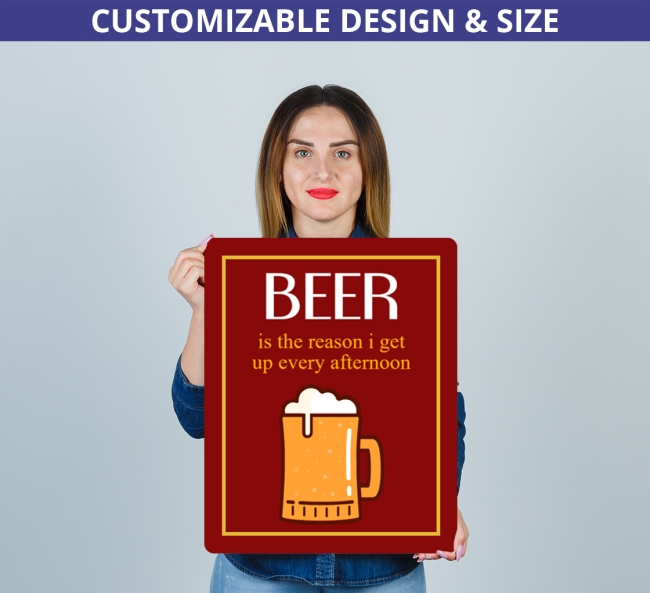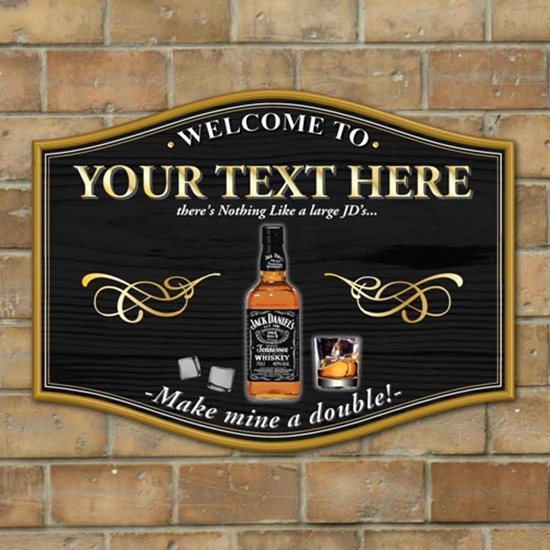There are various sizes of bar signs, based on the function of their design, the location they're put, and how they look. This is how the different size variations affect bar signs' functionality and appeal. Large Signs
The goal of the arrow is to draw attention and act as a focal-point.
Uses: Exterior signage or main branding signs or feature walls.
Placement - Usually placed outside, above large entrances or on large walls to attract customers.
Examples include large neon signs vintage-style signs, mural-type signs.
2. Medium Signs
Uses: Give information or decorate the room without being overpowering.
Uses for: Signs for direction, menu boards, and promotional displays.
Placement: Positioned in a way that's easily visible but not too overwhelming. For example, behind the bar, above seating areas or on feature walls.
For instance, medium-sized chalkboards with daily specials or metal signs that feature the bar's logo.
3. Small Signs
The purpose is to add subtle decorative elements or to give specific details.
Uses : Table signs, decorative items, labels, etc.
Tables, shelves or in displays where close-up view is required.
You could use small quotes or drink menus to illustrate.
Size Factors
Visibility
Large Signs: Made to be visible from a distance, which makes the perfect choice for attracting people as well as establishing the bar's popularity.
Medium Signs They are perfect to balance visibility and efficiency and providing important information, without imposing decor.
Small Signs (small signs) Small Signs (small signs): These are great for intimate and close-up information that are displayed at eye-level.
Proportion
Large Signs: Must be proportionate to the space to avoid overwhelming smaller areas. Ideal for large or open areas.
Medium Signs: Suitable for most interior spaces and can be placed in a variety of ways.
Small signs are great for adding a little detail to small areas and placing them in smaller spaces without causing chaos.
Impact
Signs in large sizes are a great way to create an impact and can make a significant branding component. They are often used to set the mood for the bar.
Medium Signs (Medium Size) is a way to balance the appearance and visibility. Enhances the overall atmosphere while delivering important information.
Small Signs (Signs) are a great way to add detail and charm to an experience.
Practicality
Because of their dimensions, large signs can cost a lot.
Medium Signs are easier to set up and move. They also provide flexibility with regard to modifications to the design.
Small Signs. Very versatile, simple to change and update. Perfect for environments that are dynamic.
Functionality
Large Signs: Primarily for visibility and attraction.
Medium Signs provide both essential information and aesthetic appeal.
Small signs: These are typically functional, giving specific details. They can be used to enhance the overall design of the space in a subtle manner.
The dimension of bar signage is determined by their purpose, the layout and effect they wish to create on customers. This balance ensures the importance of the sign to the bar atmosphere and the operational requirements. View the recommended view website for bar sign for site recommendations including signs for the bar, personalised outdoor pub signs, large bar signs, bar wall signs, garden bar signs, bar sign design, pub bar signs, indoor bar signs, bar sign outdoor, garden bar sign personalised and more.

The Durability Of Bar Signs Can Vary.
The tensile strength of bar signs varies according to the materials used, construction and location and the purpose for which they are intended. Here are some bar signs that differ in durability. Material
Metal signs are resistant to corrosion and durable They can also be used outdoors.
Wood: Solid wood signs are long-lasting, but they could require some maintenance to keep them from becoming rotten or warping.
Acrylic Signs: These signs are light and durable. They are resistant to shattering and can be used outdoors.
Neon/LED Neon signs tend to be delicate and easily damaged. LED signs, however, are durable, and they are also more efficient in energy use.
2. Weather Resistance
Outdoor Signs - Signs exposed outdoors require materials and finishes that resist fading, corrosion, or water damage.
Indoor Signs: While not subjected to extreme weather conditions, indoor signs should be able to withstand extreme temperatures, humidity and wear and wear and.
3. Construction
Signs with solid construction, including reinforced corners and durable mounting hardware, are more resistant to harm.
Sealed Components Signs with sealed electronic components (for illuminated sign) are more resistant to water damage.
4. Maintenance Requirements
Bar owners who are busy will appreciate signs that require only minimal maintenance, for example, periodic cleaning.
Signs that require high maintenance: Signs with intricate designs or delicate materials could be a laborious and costly to maintain.
5. Location
Indoor Signs: As indoor signs are usually less susceptible to environmental dangers the requirements for their durability could be lower than those of outdoor signs.
Outdoor Signs. Outdoor signage must be robust. It should stand up to the sun's rays, rain or wind and variations in temperature.
6. Impact Resistance
Heavy-Duty signs: Signs intended to be erected in highly-traffic areas or in other locations that may be susceptible to impact, for instance bars that are crowded, must be made of sturdy materials that resist denting and scratching.
Signs that have laminated or protected surfaces are less prone to be damaged by spills, scratches or vandalism.
7. Longevity
Longevity: The signs are designed to withstand years of use without major degradation, and provide an excellent return on investment for bar owners.
Signs for promotions that are intended for short-term or events do not necessarily require the same durability as those intended for long-term use.
8. Lighting
Lighting Components - In order to guarantee durability and longevity, illuminated signs using neon or LED lighting should be made with high-quality components.
9. Environmental Impact
Signs made using sustainable and recycled materials can have a smaller environmental impact. They offer durability and functionality.
10. Customization
Customized Options: Signs that allow customization may differ in their longevity, based upon the materials used and the production methods.
Durability is an asset.
Cost-Effectiveness - Signs that last will require less frequent maintenance or replacement. This can lower the long-term cost.
Brand Image High-quality, durable signs are a positive reflection of the image of your establishment and show professionalism.
Customer satisfaction: Good conditions, signs enhance the satisfaction of customers and increase the ambience of the bar.
Take into consideration factors like the materials, the construction, the location and the maintenance requirements. This will help bar owners choose signs that are sturdy and can withstand the harsh conditions that they face in their businesses. View the top rated on front page for bar sign for website examples including garden bar signs, personalised bar signs, personalised outdoor pub signs, sign for garden bar, personalised garden bar signs, a bar sign, novelty bar signs, bar signs for home, bar signs for home bar, personalised outdoor bar signs and more.

What Are The Differences Between Bar Signs In Regulations Terms?
There are numerous rules and regulations applicable to bar signs. They are state, local and federal laws that ensure the safety of people and to ensure aesthetic standards. The following are the types of bar signs that are regulated differently:1. Dimensions and Regulations for Placement
Zoning law: This is a set of regulations that dictates where signs can be placed in relation to their size, height and distances from property lines and road, as well as other buildings.
Historical Districts. Signs of all sizes, styles, and materials are prohibited to preserve the historic character.
2. Illumination Restrictions
Light Pollution Regulations: Limit the brightness, color and duration of the illuminated signs to limit light pollution and preserve the nighttime atmosphere.
Safety: Signs should not cause glare, or distracting light that could be dangerous to drivers or pedestrians. This is particularly true near to roads.
3. Content Signage
Alcohol Advertising Some states have restrictions on advertising for alcohol. They include a ban on certain imagery or content that attracts minors, and encourages drinking to excess.
Health Warns: Laws might require the display of health warnings regarding the dangers associated with alcohol consumption or smoking.
4. Historic Preservation Regulations
Architectural Compatibility: Signs in historic districts need to be in line with the architectural style and characteristics of the region, typically needing approval from preservation boards or commissions.
Signs can be restricted by their materials, designs, and colors to ensure that they are in keeping with the historical integrity.
5. Sign Permitting Process
Permit Requirements: Bar owners must get permits prior to installing or changing signs. This might require submitting plans, paying fees and getting permission from local authorities.
Code Compliance: To guarantee accessibility and security to the public the signs must comply with building codes as well as accessibility regulations, and safety standards.
6. Sign Removal Repair, Maintenance and Removal
Maintenance Requirements Bar owners must keep their signs in good condition make sure they are structurally sound and free of any dangers. They also need to be compliant with the regulations.
Signs that have been abandoned: There could be laws that regulate the removal or abandonment of abandoned or decaying signs to preserve the beauty of the area and prevent the spread of blight.
7. Digital Signage Regulations
Content Restrictions. There may be laws that restrict the types of content displayed by digital signs. The laws may restrict flashing lights or images that offend.
Operational Limits Regulations can limit the brightness of digital signs, motion and frequency to minimize visual obstructions.
8. Penalties and enforcement
Inspections. Local authorities perform periodic inspections of signage to verify the compliance. Infractions are cited and citations are issued.
Penalties may include fines or citations for non-compliance. You may also be required to take down signs or change their design or face legal sanctions.
9. Sign Variance Process
Variance Applications: Bar owners can apply for variances to deviate from the standard signage rules, demonstrating justification for the variance as well as minimizing any adverse impacts on aesthetics or public safety.
Public Input. Certain issues may require public hearings, and/or participation from members of the community. This may include nearby property owners businesses, residents, or residents of communities that are adjacent to each other.
10. Engagement and participation of the Community
Public Consultation: Certain authorities involve local residents in the development of signage regulations via public meetings, surveys, or stakeholder meetings.
Community Benefits: Sign regulations may incorporate provisions to enhance the appearance of signs and promote local businesses or aid in revitalizing neighborhood initiatives.
Bar owners who understand and adhere to signage regulations can ensure that their signage appeal to their customers, thereby contributing positively to their local community, and complying with legal requirements. This can reduce the chance of legal issues as well as penalties or fines. Read the recommended man cave signs examples for more advice including the staying inn sign, the pub sign, personalised home bar signs, signs for the bar, design your own bar sign, the staying inn sign, signs for the bar, personalised beer sign, signs for garden bar, design a pub sign and more.
